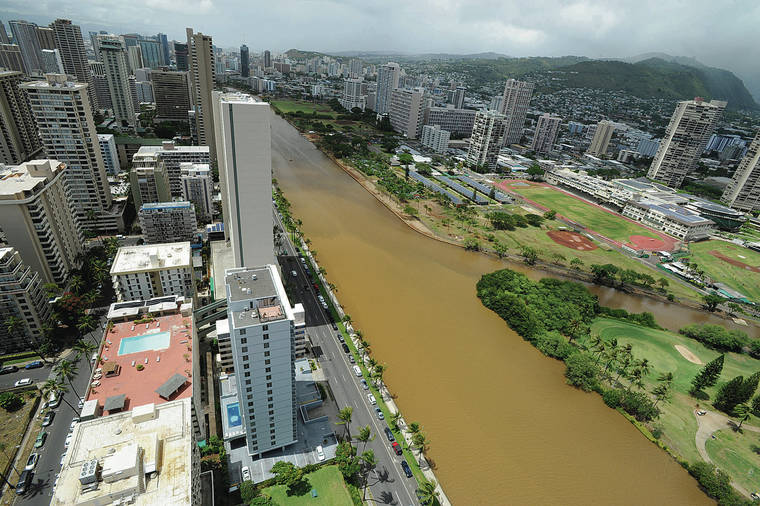The banks of the Ala Wai Canal are not at the same height: The Moiliili side is two feet lower than the Waikiki one. Moiliili will be inundated by a major flood well before Waikiki precisely at that low elevation point where the Manoa-Palolo Drainage Canal enters the Ala Wai Canal.
Iolani School and Ala Wai Elementary School, with hundred of students and staff; the many people living in the area’s residential properties; and the famed 100th Infantry Battalion Memorial Building all will be flooded without a berm protecting the Iolani school side of the Manoa-Palolo canal.
But the U.S. Army Corps of Engineers’ selected alternative does not shield the Moiliili neighborhood with on-site protection (“Engineers propose changes to Ala Wai flood project,” Star-Advertiser, Sept. 28). The map in the final environmental impact statement (EIS) indicates no flood where one surely will occur because of the low elevation.
Terminating the Moiliili floodwall at Ala Wai Canal, without protecting the Iolani side of the Manoa-Palolo Canal to Date Street, will exacerbate a flood event with greater violence, velocity and duration entering lower Moiliili, and the area will retain floodwater longer without a pump at the University Avenue site.
The alternative to spend about $350 million for a 100-year flood to protect Waikiki, but not Moiliili for a 30- or 10-year flood that is likely to come much sooner, is not OK.
Not protecting a working class and ethnic minority population like that in the Moiliili neighborhood also breaches two federal executive orders: Environmental Justice in Minority Population and Low-Income Population (EO 12898) and Protection of Children from Environmental Health Risks and Safety Risks (EO 13045).
The EIS generated an inadequate estimate of the actual socioeconomic assets and demographic weight of the Moiliili neighborhood, leading to the choice of a flawed alternative in the recommended plan. The economic cost of a flood to the Moiliili working families, many in the hotel and service sectors, should not have less weight than the damages to the cars in the garages of Waikiki. The EIS did not process the 2005 book, “Mo‘ili‘ili — The Life of a Community,” to calculate the link between the cultural-historical values with the economic values of the many assets of this neighborhood.
Importantly, we should refute the statement that it is “an unacceptable tradeoff” to protect the Iolani School site because “additional induced damages in Waikiki would greatly exceed any benefit associated with Iolani School.”
Expanding the intake lanes of the Manoa-Palolo canal into a much-extended retention basin inside the Ala Wai Golf Course will instead ensure that the excess floodwater will flow into the golf course and not on the Waikiki side. Thus an improved Army Corps plan should certainly protect lower Moiliili, which has a higher probability to flood than Waikiki.
The city, state and federal partnership can hopefully agree on a just process to implement stream maintenance with new construction, by integrating: a) low-impact design and b) constructed wetlands with living machines, as green infrastructure of a “sponge” watershed, so as to address simultaneously pollution with flood control.
Integrated ecological and flood control planning generate quite different design solutions than flood control alone. Moving forward with cleaner water, the original design of the 1920s for two ocean outlets can then becomes the definite solution to the Ala Wai Canal problem.
Luciano Minerbi is a retired professor of urban and regional planning at the University of Hawaii at Manoa.

